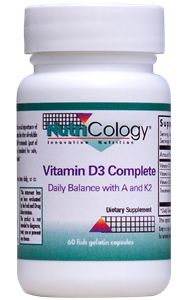This post may contain affiliate links.
Vitamin K2 and the Calcium Paradox
By Dr. Kate Rheaume-Bleue
When I say “Vitamin K”, what’s the first thing that comes to your mind? If you’ve taken any basic anatomy and physiology class, you might think “Koagulation!” (well, that was my first thought at least). For decades, we’ve been learning about Vitamin K as being essential for the blood clotting process, and we’ve been trying to get our Vitamin K through leafy greens, and hoping our gut bacteria was producing enough as well. I mean, who’s ever heard of a Vitamin K deficiency anyway?
Well, apparently our public awareness of Vitamin K is woefully underdeveloped. Unless you’re a super nerd and subscribe to Chris Masterjohn’s blog (which is awesome), you may not have even heard that there are multiple types of Vitamin K. And you probably have never heard about the role of Vitamin K in the regulation of calcium processes in the body. Well, you’re in luck, because a great, informative book is available now, called “Vitamin K2 and the Calcium Paradox” by Dr. Kate Rheaume-Bleue.
If you didn’t have the pleasure of seeing Chris’ talk on Vitamin K2 at the Weston A. Price Annual Conference in Dallas this year, fear not – this book is a wonderful review of the work Chris and other fat-soluble vitamin researchers have undertaken in the last century. The author does a great job of breaking down the role of K2 in the body, the consequences of K2 deficiency, the history of the vitamin’s discovery, the interplay between vitamins A, D and K2, and finally, how to increase vitamin K2 in our modern diets. I feel that this 8-chapter, 235-page book is a must read for anyone looking to learn more about fat soluble vitamins, the history of Weston A. Price, and/or the reasons why the Ancestral/Paleo diet can be the most healthy diet you’ll ever follow, provided you pay attention to the quality and quantity of your fat soluble vitamins.
So, what exactly is the role of K2 in the body? As Rheaume-Bleue explains in a nutshell, “Vitamin K2 funnels calcium into bones to strengthen mineral density and fight fractures while it prevents and even removes dangerous arterial calcification” (p. 4). But what does this mean in the context of the body? And how does K2 affect calcium regulation? Vitamin K2 activates, through carboxylation, a protein called osteocalcin, which attracts calcium into bones and teeth. K2 also activates matrix GLA proteins (MGPs), which remove calcium out of the soft tissues like arteries (p. 12). These K2-dependent proteins are essential for moving calcium around the body, and are regulated by the body’s levels of vitamins A and D. Therefore, when K2 is deficient, not only does bone mineral density suffer, but the calcium plaque that arises in atherosclerosis is inevitable. Your arteries literally begin to turn into fully formed bone tissue, marrow and all (p. 17). Yikes… sounds like this vitamin K2 thing is pretty important.
So, why have most of us never even heard of vitamin K2? Rheaume-Bleue explains the history of this elusive vitamin in Chapter 2 of her book, called “The Undiscovery and Rediscovery of Vitamin K2”. One of her major focuses in this chapter is the research of Dr. Weston A. Price, affectionately referred to as the “Charles Darwin of nutrition” (p. 27). Dr. Price’s incredible Indiana Jones-style research adventure took him around the world to discover the origins of modern chronic illness, and resulted in the discovery of what he referred to as “Activator X”, a compound that clearly played a vital role in the health of the many non-Western cultures he encountered. Dr. Price found that traditional diets contained at least 10 times the quantity of fat-soluble vitamins than the average Western diet (p. 33), found mainly in fatty animal foods like fish eggs, egg yolks, organ meats, and especially the butterfat of cows eating rapidly growing green grass. Dr. Price took this knowledge about the benefits of high vitamin animal fats, and used these nourishing foods to both prevent and CURE dental decay in his patients.

Weston A. Price and the Raiders of the Lost "Activator X"!
If you haven’t read Nutrition and Physical Degeneration (which admittedly I haven’t yet… whomp whomp), and you don’t know the story of Dr. Price’s research, this book is a great “Cliff’s notes” version of the history of Dr. Price’s work. If nothing else, learning the basics about Dr. Price’s study of traditional cultures and their lack of dental disease is more than enough reason to buy this book. Rheaume-Bleue includes Dr. Price’s famous pictures of natives with beautiful, straight teeth and broad, symmetric faces, as well as the before-and-after pictures of their native siblings exposed to Western foods (really wouldn’t want to be the 2nd child in those families…) If you don’t already believe that fat-soluble vitamins are the key to beautiful, healthy human beings, this chapter alone may convert you to a WAPF nerd like the rest of us!

Examples of the variation of dental decay in non-Western cultures. Amazing.
Luckily, the summary of Dr. Price’s principles of a healthy diet is great news for us Paleo/Primal kids. In summary, Dr. Price recommended the elimination of sugar, starch, and white flour (bingo!), and consuming foods that provide adequate fat-soluble vitamins, such as fish, seafood, and cod liver oil. Another stipulation of Dr. Price’s recommendations that may pose problem for old-school Paleo dieters, however, is the inclusion of grass-fed dairy products, which are especially high in vitamin K2, as witnessed by the bright orange color of the pastured cow’s products. The photosynthetic function of vitamin K is further explored in this book, and Rheaume-Bleue demonstrates why it is essential to consume animal products that have lived a life full of green grass and sunshine (besides just respecting the animal’s right to a happy life).
I know that the dairy issue is a point of contention in the Paleo community, but I’d like to point out that one of the best ways to get K2 in your diet is to cook with grass-fed Ghee, a clarified butter product that is free of any lactose or casein, a delicious cooking oil, and full of healthy vitamin K2. If you’re not including dairy in your Paleo diet right now, I’d recommend at least starting to cook with ghee, which is incredibly healthy and won’t cause any negative reactions associated with the dead, pastuerized milk products that you might have been eschewing until now.

Pure Indian Foods makes a WONDERFUL grass-fed Ghee!
I feel that this book will really appeal to those Paleo dieters who appreciate the evolutionary argument. One of my favorite lines in this book (which can be used as intellectual ammunition against your vegan adversaries) is: “Homo sapiens seem to convert very little K1 to K2, possibly because we evolved to a place in the food chain that provided us with ample sources of preconverted K2, so we lost the ability to make it ourselves.” BAM. In other words, humans MUST get their vitamin K2 as the pre-formed nutrient found only in animal products. Ancestral Diet 1, Veganism 0. (I haven’t been keeping score. We’re probably winning by much more points than that.) Rheaume-Bleue asserts that by consuming animal foods, humans have been profiting from the conversion of the sun’s energy and the soil’s minerals into usable nutrition. This is another reason why it’s important to be mindful about the quality of our animal products; if we are what we eat, then we are also what our animals eat (p. 51). Because of this, you should always make sure you are eating plenty of eggs from pastured chickens, grass-fed beef, and butter or ghee from grass-fed cows. Eating conventional, grain-fed animals won’t do much to help your Vitamin K2 status.
Interestingly, this book also supports the ‘no grains’ philosophy that many of us Paleo dieters adhere to. It turns out that phytic acid, found in whole grains and legumes (and raw nuts too), actually blocks the absorption of important minerals such as zinc, iron, calcium, and magnesium, as well as defeating vitamin D intake and subsequently jeopardizing vitamin K2 activity (p. 231). While phytic acid can be neutralized by proper preparation of the grains (soaking, sprouting, fermenting), it may well be that our MO of avoiding grains altogether may be beneficial for restoring our fat-soluble vitamin stores. While properly prepared grains may be a healthful addition to the diet, I’m sure many of you agree with me that avoiding grains on a regular basis is a much easier way to reduce phytate load in the diet. (Now you just need to start soaking your raw nuts…)
Vitamin K2 is especially crucial in the context of vitamin A and D in the body. Vitamins A and D are essential for the production of the vitamin K2 dependent proteins osteocalcin and MGP, which are needed to make use of the calcium in our diets in a proper way. Preformed vitamin A (retinol) and vitamin D (cholecalciferol) is only obtained from animal foods (p. 185), and a deficiency or excess of one will cause a subsequent inverse level of the other. In other words, taking excessive vitamin D supplements without paying attention to vitamin A and K2 will lead to the symptoms of toxicity that many of us have been warned about in the past. Having these three nutrients in balance is a vital component of optimal health, and deficiencies or excesses can be extremely dangerous if allowed to continue over time.
For example, run your hand over the back of your arm. Is it bumpy? This is follicular hyperkeratosis, one of the first signs of a vitamin A deficiency (p. 191). I mention this symptom specifically because up until recently, I had been dealing with uncomfortable, unsightly bumps all over my arms and face (see my About Me page) after spending a year in Australia eating the standard Western diet (not by my own choice). Whether that was a symptom of excess vitamin D due to the sun, or a serious vitamin A or K2 deficiency, or a combination of the three, I can say from my own experience that deficiency in fat-soluble vitamins is an easy state to enter if you’re not careful about the food you eat. Thankfully for me, an Ancestralized diet with a strong focus on including fat-soluble vitamin-rich foods has just about cured my skin ailments, and I plan on greatly increasing my attention to vitamin K2 after seeing Chris’s talk, and even more so now that I’ve read this book.
The complementary action of these three fat-soluble vitamins (A, D, and K2) is well described in this book, and on awesome websites such as Chris Masterjohn’s blog, so I’ll leave you all to read up on this on your own (sorry!). The key point to take out of this knowledge, however, is that many of the symptoms of vitamin A toxicity are actually caused by an induced deficiency of vitamins D and K2, and vice versa (p. 194). Therefore, if you are doing any supplementation, it is essential that you include all three of these nutrients in your daily regimen. Look for a supplement that contains all three (I take Nutricology brand), and make sure you’re including adequate quantities of vitamin-rich animal products.

Nutricology Vitamin D3 Complete
If you are looking for the best foods to incorporate into your diet to maximize your K2, A, and D status, I would suggest eating lots of pastured whole eggs, organ meats from grass-fed animals, raw cheeses and raw dairy products, butter or ghee from grass-fed ruminants, and taking cod liver oil on a regular basis.
I encourage you to pick up a copy of “Vitamin K2 and the Calcium Paradox” (available on Amazon) to learn more about the importance of fat-soluble vitamins in your diet!
+ show Comments
- Hide Comments
add a comment